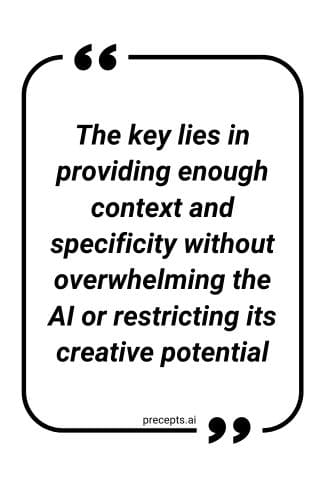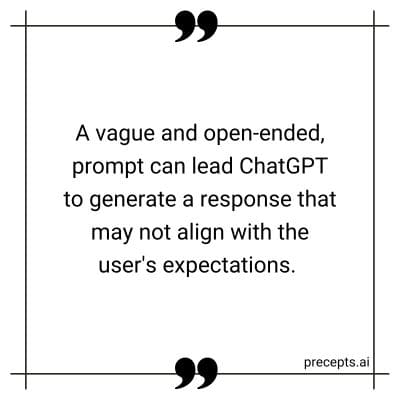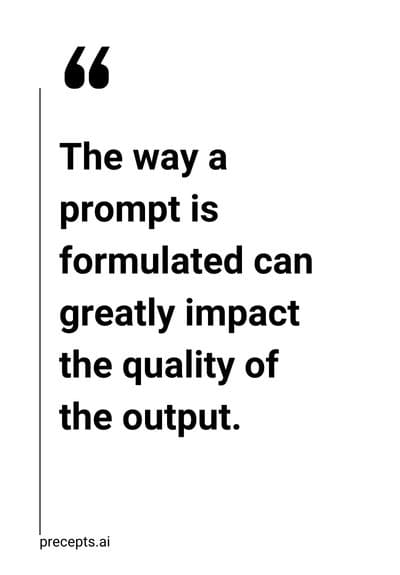Mastering ChatGPT Prompts: Unlock the Full Potential of AI Responses
ChatGPT, developed by OpenAI, is an advanced AI model that has gained immense popularity in recent months due to its remarkable ability to understand and generate human-like response to the given ChatGPT prompts. It leverages cutting-edge machine learning techniques and an enormous dataset to produce coherent, contextually relevant, and creative AI responses based on the input it receives.
From content generation to answering questions, ChatGPT has a wide range of applications that are transforming industries and simplifying complex tasks. ChatGPT is being used to generate blog posts, social media updates, ad copies, and more, saving businesses and individuals valuable time and effort. Additionally, it is being employed to assist with customer support, where it can swiftly answer user queries and provide relevant information based on the context.
Beyond content and customer support, ChatGPT has found its way into various other domains as well. For instance, educators and students are using it to help with assignments, research, and language learning. Marketers are leveraging its capabilities to optimize their campaigns and create engaging promotional materials. Meanwhile, developers are integrating ChatGPT into their applications, enabling users to interact with the AI through natural language interfaces.
One key aspect of utilizing ChatGPT to its fullest potential lies in crafting effective prompts. By mastering the art of prompting, users can significantly improve the quality of the AI-generated responses and unlock the true power of ChatGPT for their specific needs. In this blog post, we will explore –
- The role of ChatGPT prompts
- Crafting Effective Prompts: The Key to Unlocking the True Potential of ChatGPT
- Context and Phrasing: Unlocking the Potential of ChatGPT with the Right Approach
- Experimentation and Iteration: Refining Prompts to Unleash the Full Potential of ChatGPT
- Navigating Sensitive Content: The Importance of Responsible ChatGPT Prompts
- The Journey of Mastery: Continual Learning and Improvement in Prompting Techniques
- Leveraging Resources and Community Support for Effective Prompting
- Conclusion: Art of Using Effective Prompts for Optimal ChatGPT Results
The role of ChatGPT prompts:
Prompts play a crucial role in guiding the behavior and output of ChatGPT. Essentially, a prompt acts as the input or the starting point for the AI model, providing it with the necessary context and information to generate a response. When you supply a well-crafted prompt to ChatGPT, it can result in a more accurate, relevant, and contextually appropriate output. Therefore, understanding how to create effective prompts is fundamental to maximizing the benefits of using ChatGPT.
 The quality and relevance of ChatGPT’s output are heavily influenced by the prompts given to it. This is because the AI model is trained to process the input text and generate responses based on the patterns it has learned from its extensive training data. Consequently, if the prompt is vague, ambiguous, or poorly structured, it can lead to outputs that are less than desirable, as the AI may struggle to comprehend the intent or context behind the prompt. However, when a prompt is clear, concise, and well-structured, it enables ChatGPT to draw upon its vast knowledge base and generate responses that align closely with the user’s expectations.
The quality and relevance of ChatGPT’s output are heavily influenced by the prompts given to it. This is because the AI model is trained to process the input text and generate responses based on the patterns it has learned from its extensive training data. Consequently, if the prompt is vague, ambiguous, or poorly structured, it can lead to outputs that are less than desirable, as the AI may struggle to comprehend the intent or context behind the prompt. However, when a prompt is clear, concise, and well-structured, it enables ChatGPT to draw upon its vast knowledge base and generate responses that align closely with the user’s expectations.
The key lies in providing enough context and specificity without overwhelming the AI or restricting its creative potential. To achieve this delicate balance, it is important to understand two essential concepts in AI language modeling: Perplexity and Burstiness.
- Perplexity refers to the level of uncertainty an AI model experiences when predicting the next word in a given sequence. A lower perplexity implies that the model is more confident in its predictions, which usually translates to higher-quality outputs.
- Burstiness, on the other hand, relates to the tendency of the model to generate repetitive or redundant responses. Minimizing burstiness ensures that the AI-generated text remains diverse and engaging.
When crafting prompts for ChatGPT, it is crucial to strike the right balance between perplexity and burstiness. This can be achieved by providing sufficient context and information in the prompt while maintaining a concise and focused structure.
Crafting Effective Prompts: The Key to Unlocking the True Potential of ChatGPT
Creating effective prompts requires striking a balance between providing adequate context and being concise. Clear, specific, and concise prompts minimize the model’s perplexity, allowing it to predict the next word in a sequence with greater confidence. This, in turn, results in more accurate and coherent outputs. On the other hand, addressing burstiness ensures the diversity and engagement of AI-generated text by avoiding repetitive or redundant responses.
Consider the following examples to understand the impact of good and bad prompts:
Bad Prompt: “Tell me about AI.”
Good Prompt: “Please provide a brief overview of the history and applications of artificial intelligence.”
 The first prompt is vague and open-ended, which can lead ChatGPT to generate a response that may not align with the user’s expectations. In contrast, the second prompt clearly specifies the user’s intent, ensuring a more focused and relevant response.
The first prompt is vague and open-ended, which can lead ChatGPT to generate a response that may not align with the user’s expectations. In contrast, the second prompt clearly specifies the user’s intent, ensuring a more focused and relevant response.
Bad Prompt: “Why is it important to use good prompts when using AI language models like ChatGPT?”
Good Prompt: “Discuss the significance of crafting effective prompts for AI language models such as ChatGPT and its impact on the quality of generated responses.”
The first prompt, while more specific than the previous bad example, still contains redundant information that could affect the clarity of the response. The second prompt, however, is concise and directly addresses the desired topic, leading to a more coherent and focused output.
In addition to clarity and conciseness, it’s important to maintain a professional yet approachable tone in the prompts. This tone fosters rapport with the audience, contributing to the effectiveness of the prompts and the generated responses. For instance:
Bad Prompt: “Hey, can you give me some cool facts about the solar system?”
Good Prompt: “Please share five interesting facts about the solar system.”
The first prompt exhibits an informal tone, which may not be suitable for all audiences or applications. The second prompt, conversely, maintains a professional yet approachable tone, catering to a wider range of users.
Context and Phrasing: Unlocking the Potential of ChatGPT with the Right Approach
To fully harness the capabilities of ChatGPT, it is essential to understand the importance of context and phrasing in formulating prompts. By providing appropriate context and employing the right phrasing, users can significantly improve the accuracy and utility of the generated responses.
For instance, consider the following examples:
Bad Prompt: “Explain the significance of renewable energy.”
Good Prompt: “Considering the increasing global energy demand and the need for sustainable energy sources, explain the importance of renewable energy.”
 The first prompt lacks context, which might lead to a generic response from ChatGPT. The second prompt, however, provides essential background information, directing the AI to generate a more specific and focused response that aligns with the user’s intent.
The first prompt lacks context, which might lead to a generic response from ChatGPT. The second prompt, however, provides essential background information, directing the AI to generate a more specific and focused response that aligns with the user’s intent.
In addition to context, phrasing plays a crucial role in eliciting accurate and useful responses from ChatGPT. The way a prompt is formulated can greatly impact the quality of the output. Users should aim for clarity and precision in their phrasing while maintaining a professional yet approachable tone.
For example:
Bad Prompt: “How do we make AI more human-like?”
Good Prompt: “Discuss the techniques and strategies employed in developing AI models that exhibit human-like behavior and comprehension.”
The first prompt is imprecise and might lead to a broad or ambiguous response. The second prompt, on the other hand, employs clear and specific phrasing, prompting ChatGPT to generate a more detailed and informative output.
When crafting prompts, it is vital to strike a balance between providing adequate context and using the right phrasing to optimize the AI’s responses. By focusing on these aspects users can significantly enhance the accuracy and usefulness.
Experimentation and Iteration: Refining ChatGPT Prompts to Unleash the Full Potential of AI
When it comes to interacting with ChatGPT, getting the desired response often requires a process of experimentation and iteration. By testing various approaches and refining prompts, users can unlock the full potential of ChatGPT and create AI-generated content that is engaging, accurate, and highly useful. Experimenting with different prompts is crucial to discovering the most effective ways of communicating with ChatGPT. Users should not shy away from trying multiple approaches, as each attempt brings them closer to the ideal prompt that generates the desired output.
Here are a few strategies that can help users experiment and iterate on their prompts:
Vary the level of detail: Adjust the amount of context provided in the prompt to see how it affects the AI-generated response. Users may find that offering more background information leads to richer and more accurate outputs.
Rephrase the question: Experiment with different ways of posing the question or request to see how it impacts the AI’s response. This can help users identify the phrasing that produces the most relevant and accurate results.
Use instructive language: Incorporate guiding instructions in the prompt, such as asking the AI to think step-by-step or to provide specific examples. This can help users obtain more focused and informative responses.
Adjust the prompt’s format: Users can try presenting their prompts in different formats, such as a question, a statement, or a request for elaboration. Changing the format can yield diverse responses, allowing users to identify the approach that best suits their needs.
By embracing a mindset of experimentation and iteration, users can refine their prompts and better understand how to communicate with ChatGPT effectively.
Navigating Sensitive Content: The Importance of Responsible ChatGPT Prompts
While AI language models like ChatGPT can produce remarkable results in a wide range of applications, it is essential to approach sensitive and potentially inappropriate content with caution. Ensuring responsible use of ChatGPT involves crafting prompts that adhere to ethical guidelines, avoid sensitive topics, and maintain a tone that is both professional and approachable.
 Understanding how ChatGPT is trained to handle sensitive content is critical for users looking to utilize the AI model responsibly. The model’s training data is derived from a diverse range of sources, which can include various viewpoints and information on sensitive topics.
Understanding how ChatGPT is trained to handle sensitive content is critical for users looking to utilize the AI model responsibly. The model’s training data is derived from a diverse range of sources, which can include various viewpoints and information on sensitive topics.
To ensure that the AI produces content that aligns with ethical guidelines, developers employ a two-step process: pre-training and fine-tuning. During pre-training, ChatGPT learns language patterns, facts, and reasoning abilities from a vast corpus of text. However, this phase may also expose the model to inappropriate or biased content. To mitigate this risk, developers fine-tune the model using a more controlled dataset, which incorporates guidelines and restrictions to generate content that is ethical, safe, and useful.
Despite these efforts, it remains crucial for users to craft their prompts carefully and responsibly, particularly when handling sensitive content. Here are a few tips for users to consider when approaching such topics with ChatGPT:
- Be explicit with your intentions: Clearly state the desired outcome or information you are seeking, while specifying that the response should adhere to ethical guidelines and avoid inappropriate content.
- Set boundaries: Provide explicit instructions on the topics or information that should not be included in the AI-generated response. Establishing clear boundaries helps ensure that the content produced aligns with the user’s intent and ethical considerations.
- Monitor the AI’s output: Regularly review the generated content to identify and address any instances of inappropriate or sensitive material. Users should remain vigilant and adjust their prompts as needed to ensure the AI’s responses stay within acceptable boundaries.
- Iterate and improve: Continuously refine your prompts to optimize the balance between perplexity and burstiness, while maintaining a professional and approachable tone. This process can help users achieve the desired results while steering clear of sensitive or inappropriate content.
By crafting prompts responsibly and understanding how ChatGPT is trained to handle sensitive situations, users can make the most of the AI’s capabilities while adhering to ethical guidelines.
The Journey of ChatGPT Mastery: Continual Learning and Improvement in Prompting Techniques
Mastering the art of crafting effective prompts for ChatGPT is an ongoing journey, requiring continuous learning and adaptation. By embracing the process of trial and error and refining their prompting techniques, users can progressively unlock the full potential of AI-generated content. To excel in the art of prompting, it is essential to recognize the learning process as a critical component of success. Here are some tips to foster continual growth and improvement in your prompting techniques:
- Embrace experimentation: Be open to trying different approaches, phrasings, and contexts when crafting prompts. By experimenting with various techniques, you can discover what works best for you and your specific goals, ultimately improving the quality of AI-generated content.
- Learn from feedback: Analyze the AI’s responses and identify areas where the output may have deviated from your expectations. Use this feedback to refine your prompts, making them more precise, contextual, and relevant to your desired outcome.
- Stay informed: As AI technology advances, new techniques and strategies for crafting effective prompts may emerge. Stay up-to-date with the latest developments and best practices in the field. Use resources like ChatGPT Blogs, Reddit Groups, Instagram Accounts etc to ensure that your prompting skills remain current and effective.
- Share and collaborate: Engage with other users of AI language models to exchange insights, experiences, and knowledge. By sharing your own learnings and learning from others, you can expand your understanding of prompt crafting and enhance your skills.
By committing to the learning process and continuously refining your prompting techniques, you can harness the power of ChatGPT more effectively. As you progress, you’ll develop the skills needed to create AI-generated content that is useful and relevant
Leveraging Resources and Community Support for Effective Prompting
Mastering the art of crafting effective prompts for ChatGPT is an ongoing journey, requiring continuous learning and adaptation. By embracing the process of trial and error and refining their prompting techniques, users can progressively unlock the full potential of AI-generated content. To excel in the art of prompting, it is essential to recognize the learning process as a critical component of success. Here are some tips to foster continual growth and improvement in your prompting techniques:
- Embrace experimentation: Be open to trying different approaches, phrasings, and contexts when crafting prompts. By experimenting with various techniques, you can discover what works best for you and your specific goals, ultimately improving the quality of AI-generated content.
- Learn from feedback: Analyze the AI’s responses and identify areas where the output may have deviated from your expectations. Use this feedback to refine your prompts, making them more precise, contextual, and relevant to your desired outcome.
- Stay informed: As AI technology advances, new techniques and strategies for crafting effective prompts may emerge. Stay up-to-date with the latest developments and best practices in the field. Use resources like ChatGPT Blogs, Reddit Groups, Instagram Accounts etc to ensure that your prompting skills remain current and effective.
- Share and collaborate: Engage with other users of AI language models to exchange insights, experiences, and knowledge. By sharing your own learnings and learning from others, you can expand your understanding of prompt crafting and enhance your skills.
By committing to the learning process and continuously refining your prompting techniques, you can harness the power of ChatGPT more effectively. As you progress, you’ll develop the skills needed to create AI-generated content that is useful and relevant
Leveraging Resources and Community Support for Effective Prompting
The power of AI models like ChatGPT can be harnessed more effectively when users make use of available resources and engage with the wider AI community. By leveraging platforms like precepts.ai and participating in the ChatGPT community, users can discover a wealth of knowledge and support to enhance their prompting skills and achieve better results.
- Utilize specialized resources: Platforms like precepts.ai offer a vast library of well-crafted prompts, spanning across numerous categories and industries. Users can draw inspiration from these resources to create more effective prompts, enabling ChatGPT to produce content that is accurate and relevant.
- Engage with online forums and groups: The ChatGPT community is an invaluable source of knowledge and support. By actively participating in online forums, groups, and social media platforms dedicated to ChatGPT, users can learn from others’ experiences, discover new techniques, and gain insights into crafting better prompts.
- Attend workshops and webinars: Many organizations and industry experts offer workshops, webinars, and training sessions on AI language models and ChatGPT prompt crafting. Attending these events can provide users with a deeper understanding of the technology, as well as practical tips and strategies for improving their prompting skills.
- Share your experiences: Sharing your own journey and learnings with the ChatGPT community can contribute to the collective knowledge and inspire others to explore new techniques and approaches. By giving back to the community, users can foster a supportive and nurturing environment for continuous growth and improvement.
Leveraging resources like precepts.ai and engaging with the ChatGPT community can significantly enhance a user’s ability to craft effective prompts. By using the available prompts provided by precepts.ai, users can refine their prompting techniques, resulting in unlocking the full potential of ChatGPT.
Conclusion: Art of Using Effective Prompts for Optimal ChatGPT Results
Harnessing the power of ChatGPT to its fullest potential relies heavily on the skill of crafting the right prompts. The quality of the input given to ChatGPT has a direct impact on the relevance, accuracy, and usefulness of its output, making prompt mastery essential for success.
To achieve the best results from ChatGPT, it’s vital to keep learning, experimenting, and refining your prompting techniques. Engage with available resources like precepts.ai and the ChatGPT community, as they provide invaluable ready to use prompts, inspiration and support for users looking to hone their skills.
Mastering the art of ChatGPT prompt creation is crucial for getting the best results from ChatGPT. Keep exploring, learning, and growing, and remember that the world of ChatGPT is yours to conquer with the right mindset and resources.




